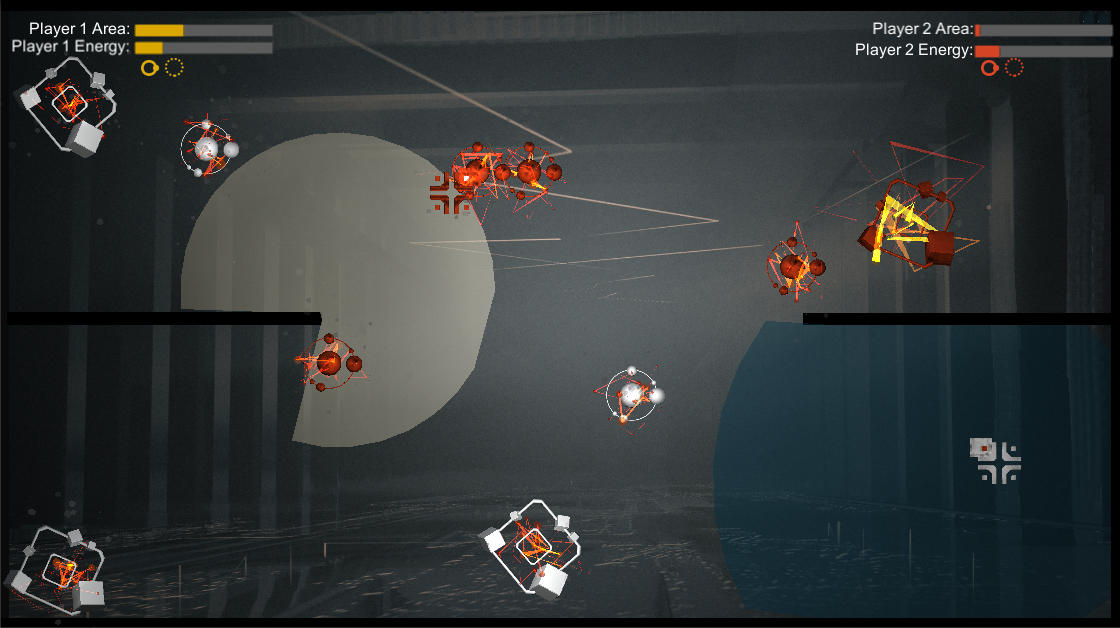Description
In the distant year XX20 a team of physicists and engineers developed a machine capable of manipulating subatomic particles with incredible precision. The creation of this machine revolutionized nano scale manufacturing, allowing for technological advancement in a variety of fields. Late one night, after celebrating their accomplishments, the team began repurposing their equipment to settle a bet. Could it be used to play a game? After years of developing a scientific instrument, they began work on something entirely different. Each player had control of their own machine aimed at particles and antiparticles suspended in a Bose Einstein Condensate. The goal? Control of the field, no matter how small it may be.
Regrettably, this is not that game. It is merely an approximation of something from a future that may one day come to be.

How to play the game?
The game is a competitive two player local multiplayer game. Each player is assigned a set of controls displayed on the beginning screen.

When a particle and antiparticle, represented by square and round units respectively, collide they create a pair of entangled photons. However, it is impossible to know their exact location and speed. Instead, an approximation of where they could be at any time is shown. By placing your units within that area you may gather the photon, giving you the energy you need to create more units. Once one of the entangled photons has been collected, its pair is revealed.
This energy can be used to create both new particles and antiparticles as well as heavier atoms which claim an area around them. Only your units are able to pass through this area. The first to control enough of the field is the winner.
How was this game made?
This game was developed by team 2 of the Spring 2020 Aalto Quantum Games course over the span of approximately a month. The idea was conceived during the initial kick-off session and a group of individuals united to bring this idea to life. The team was composed of four members, although regrettably one did not have time for the course and as such had to leave the project halfway through. Each member had their own specialization, whether that was art, sound design or code. The project was developed over several iterations with each prototype implementing new features and implementing quantum principles as game-mechanics in different ways. One could argue that the group utilized several principles of agile software development.
How is this related to quantum?
The game was unable to use quantum computer integration due to issues regarding latency. Instead, the game concept and mechanics were inspired by quantum concepts. The uncertainty about the location of photons and the heavy atoms claiming area and so on. Each conversation with a quantum physicist gave the team a new shot of inspiration that led to the addition of a new mechanic. What story there is was also inspired by some of the stories from the kick-off session.
Tools
Unity 2018.4.X (19f1, 22f1) (game engine), Notepad++ and Visual Studio (Although any editor works. It’s just a matter of preference.), Pro Tools (Sound asset editing), Wwise (Audio engine), Arturia Analog Lab 4 (Software synthesizer), Blender 3D (3d model creation), Adobe Photoshop (Textures, concept art, etc)
Team & credits
Saku Anttila – Sound, Project Manager, Game Design, Level Design
Niilo Kämäräinen – Graphics, 3d Modeling, Game Design
Antti Matikainen – Code, Unity Poking, Game Design

Downloads
Executable: https://drive.google.com/open?id=1b8gXQ89jvfW5l0004FHu2UG-ZLivYyBC
Game Source: https://drive.google.com/open?id=1Tt45LGQ7OHPoL7yGZizZvMkg03lMO709